

|
Player's Journal 2006 2015 2014 2013 2012 2011 2010 2009 2008 2007 2006 2005 2004 2003 2002 12/03/2006 Will Play for Food 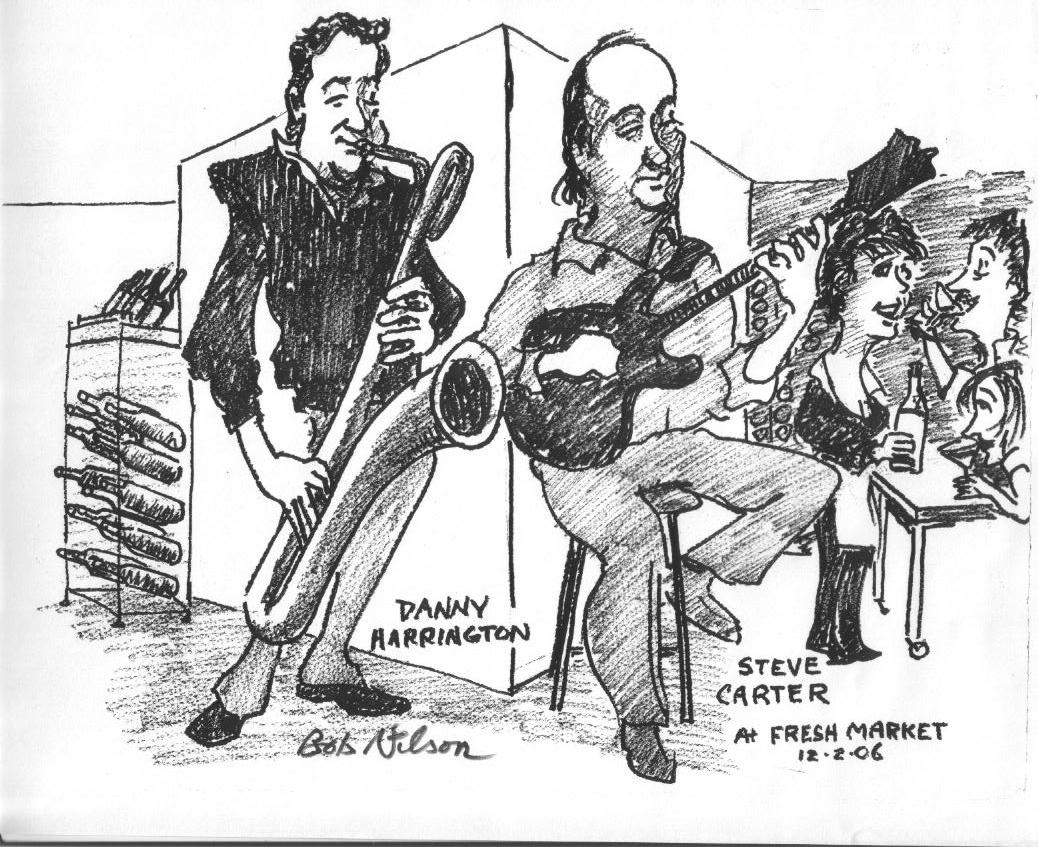
Philbrick's Fresh Market is a high-end grocery store in Portsmouth, NH. I was shocked to walk in there one weekend in October and see a jazz trio set up in the produce section. There, among the organic carrots and the squash, were three fine local jazz players I had heard frequently at local restaurants and bars. October was customer appreciation month at Philbrick's, and they were offering live music. Shop and bop. Philbrick's has decided to have live music every Saturday in December, and I was fortunate enough to land the gig. My old Berklee buddy Danny Harrington was avaialable, so we're doing the gig as a duo. We played yesterday and I think Danny enjoyed it as much as I did. We set up in section where they sell wine. There was a wine-tasting going on, as well, so it was quite a festive atmosphere. At one point, we played "Alice in Wonderland" and a couple began dancing in the aisle near us. We spotted other couples dancing off and on during the three-hour gig. What fun! At one point a gentleman pulled up a low-slung folding chair, sat down in front of us, took out a sketch pad, and started drawing us. It was Bob Nilson, a local fixture at jazz shows. I've seen him a couple of times at the Press Room, drawing caricatures of the jazz players. Click here to see the sketch. 11/15/2006 Day After Often, the day after a solo gig, I take a day off from the guitar. This makes sense when I have a lot of solo gigs close together, because it gives my hands a rest. But last night I had a solo gig after not having any gigs for a couple of weeks, so tonight I took some time to play through some of the tunes that had been a little ragged last night. I think that was a good idea. 11/12/2006 Charmed, Mr. Bird 
It's been a productive few days for composing. During a lesson earlier in the week, I had discussed modal vamps, and that got me to thinking. That night I sat down with the guitar and worked out an Aeolian vamp. I began getting ideas that I couldn't execute on the guitar. I gave up on it and went to bed, but as I was falling asleep it came to me that what I should do is orchestrate it using Notion. The next morning I set to work on notating the vamp for strings. The great thing about Notion is that as soon as you write something, you can hear it played back using sounds recorded by the London Symphony Orchestra. I have my computer hooked up to the stereo system in my office and as I listened to the playback my wife, Mal, came in and said, "Are you writing new age music? I thought I heard you playing new age music on the guitar last night." It did sound very new age. Mal was scheduled to teach a Reiki class at our house the next day. She said, "Can I play it in my class?" I said, "It's not finished; it's just a sketch." Well, I knew at that point I was committed -- commissioned, sort of. So I expanded a bit on the string parts, added a flute, and, after a couple of hours of tweaking, had a 3-minute piece that I was pretty happy with. In keeping with it's intended use, I named it "Charm." Notion allows saving to a wav file, so I saved it and burned it to CD. Mal played it at her class the next day, and it was a hit. So I guess I have the start of my first New Age CD. The other piece I wrote is called "Mr. Bird." There's quite a story behind it. Recently Mal and I had spent the night with some friends, Linda and Albert. They had a new addition to their family: a bird. It seems that during the summer Albert had been in the yard and a bird had flown down from a branch and sat on his shoulder, flying away after a while. This was in Medford, MA, and this was no ordinary Medford crow; it was a green bird with a tufted head and pink cheeks. The bird's visits went on for a few days, and Albert concluded that the bird did not have a home. As luck would have it, Albert had a bird cage had long gone unused. Albert adopted the bird. When Mal and I arrived for our visit, Linda set out cheese and crackers in the kitchen, which happens to be where the bird's cage is. The door is always open on the cage, and the bird goes in and out, spending most of his time sitting on the top of the cage, pecking at the millet seeds Albert has hung there, and occassionally pecking at the kitchen curtains. As we had wine and cheese, the bird became the topic of conversation. Albert had named him with some phrase in Italian that sounds very romantic, and translates to "bird I found." Mal and I couldn't pronounce -- let alone remember -- the Italian, so we referred to him as Mr. Bird. We learned that Mr. Bird liked jazz. When Linda and Albert go out to work in the morning, they leave the radio in the kitched tuned to a jazz station. Keeps Mr. Bird from getting lonely. When Mal heard that Mr. Bird liked jazz, she said to me, "You should write him a song." Mr. Bird seemed to have a fascination with me. He kept staring at me, tilting his head first one way, then the other, the tuft on his head rising and falling. Linda said, "He likes men." They weren't really sure whether Mr. Bird was a Mister or a Ms. The next morning, Linda and Albert went off to work early, but they had left breakfast for us in the kitchen. As I drank my coffee, Mr. Bird stared at me and listened to jazz. At one point I left the kitchen and Mr. Bird started shrieking. All the time I was out of the room he shrieked, stopping only when I came back. As we were finishing breakfast and packing to leave, I went in and out of the kitchen several times, and every time Mr. Bird shrieked all the time I was gone. When I remained in the kitchen, and Mal left the room, Mr. Bird calmly listened to jazz on the radio. Once we were all packed up and ready to leave, I headed back through the dining room toward the kitchen, to make sure that I had turned of the coffee pot, and that Mr. Bird had a good jazz station to listen to. Mr. Bird came flying out of the kitchen, circled the dining room a few times, and settled on my shoulder. I was quite flattered by the attention, but I needed to leave and preferred not to walk out the door with a bird on my shoulder. I walked into the kitchen and leaned over near the cage so Mr. Bird could hop off, but he had no such intention. He was seated on my left shoulder, and as I leanded that shoulder near the cage he scurried down my shoulder, behind my head, and over to the right shoulder. I leaned my right shoulder near the cage and Mr. Bird repeated his little maneuver in reverse. This little dance went on for several minutes. Mal found it quite amusing. I was getting a little peeved. "Mr. Bird," I said, "You're very nice, but I really do need to leave now." I tried to get him to light on my finger, thinking that thusly I could transfer him to the roof of his cage, but he disapproved of that and demonstrated the fact by snipping at my finger. Finally, after much stooping, scurrying, and coaxing, Mr. Bird hopped off my shoulder and on to the cage. Mal and I beat a hasty retreat down the stairs and out the front door. In the kitchen, the jazz was playing on the radio, but I don't think Mr. Bird could hear it over his screeching. I guess that was his way of saying Goodby. The idea for my song had come to me while I was shaving that morning (to the accompaniment of Mr. Bird shrieking in the kitchen). Charlie Parker had been called "Bird" -- short for "Yardbird" -- because he loved to eat chicken. (Of course I wouldn't mention that fact in the presence of Mr. Bird. He'd get distressed.) Bird had written a tune named "Yardbird Suite," so I would write a tune based on that tune. After all, Bird took the melody for the bridge from standard tune, and he was always writing creating songs by composing new melodies on the chords of standard tunes, so my little piece of "borrowing" would be right in the tradition. Now I had a chord progression, and I could use a few notes from the melody as the basis of my melody. But what would the style be? I had been wanting to write a Bossa Nova, and I rationalized that Mr. Bird was probably a species from the Brazillian rain forest, so I was all set. (I later learned that Mr. Bird was a cockatiel, a species native to Australia. I have no idea what native Australian music sounds like, and I have no desire to compose for didgereedo, so as far as I'm concerned, Mr. Bird is Brazillian and my tribute to him will be a piece of Brazillian-flavored jazz for the guitar.) Last night I sat down with my guitar, the lead sheet to "Yardbird Suite," and my memories of Mr. Bird. In a short while I had a new song. It turned out to be more of an uptempo Samba than a Bossa Nove, but I guess that was because Mr. Bird can be a little high-strung at times. My song does sound very jazzy, and I think Mr. Bird will like that, when he comes to one of my gigs, perched on Albert's shoulder. 10/22/2006 THoTH and Beyond In the past month I've had a lot more time for THoTH and for working on plans for workshops. I've added some new features to THoTH, and I've put together some materials for a couple of guitar workshops, one general workshop covering things like improvising and comping, and one workshop focusing on solo guitar. I'll be shopping the workshops around to schools and colleges in the near future. I've also had time to practice, to work on some recording in my home studio, and to learn a little more about Finale PrintMusic and Notion. Nice to have time. 10/20/2006 Coppertop No More All good things come to an end. I've been working Fridays and Sundays at Coppertop, and was looking forward to this weekend's gigs. This afternoon the owner called me and told me she was closing the restaurant. Business had been slow, so I can't blame her. But it was a nice gig, and I'll miss it. Time to look for something else. 09/24/2006 More Time for Music On Friday I got laid off from my day job -- and I think it's a good thing. When I quit teaching at Berklee nine years ago, I had the goal of putting more time into my playing. But, of course, it was not possible to make a comfortable living playing jazz, so I started working days as a software engineer. I rode out the dot-com boom and bust, working for various small companies. It was enjoyable and sometimes lucrative work, but as the software industry started going downhill, it became not just a day job, but a days-nights-and-weekends job. Enough. At this point, I want to just focus on music for a while. I've finally gotten my THoTH software on the market and I want to push that. I want to get back to composing music, writing guitar ensemble charts, and doing some teaching. I've had plans for my second solo CD for a while, and now I have the time to do it. My wife pointed out that I got laid off just before the Jewish New Year -- a traditional time for new beginnings. And so I begin. 09/24/2006 CopperTop is Tops I'm really enjoying the gigs at CopperTop Bistro. I started on Friday night, and -- due to a mixup in the notices in the newspaper -- did an unplanned Saturday night, and I'll be back there tonight for the regular Sunday night gig. The room has excellent acoustics, the customers and staff really enjoy the music, and I've sold a few CDs. So I'm hoping word will get out and we'll start attracting more people. The York Independent newspaper did a nice article on CopperTop Bistro and my upcoming appearances there. You can read it here. 09/04/2006 Excellent Barley Pub Gig It was a holiday weekend, and the remnants of tropical storm Ernesto had been drenching Dover all day, so I wasn't expecting much turn out for my trio at the Barley Pub. Fortunately, I was wrong. At the start of the first set, Sheri, Jason, and some of their friends came in and sat near the stage. They are always very supportive, laughing at the jokes and stories I use to introduce tunes, and applauding after tunes. As the evening went on, many more people came in, and I think the enthusiasm of our small group of family and friends proved contagious. I'll have to write up a Gig Journal about this gig, but for now I just want to acknowledge that this was one of the most enjoyable gigs I've had in years, the kind of night that makes all the hard work worth while. 09/03/2006 Coppertop Gig We went into Coppertop Bistro in York for dinner last night. The last time we'd been in there, we'd talked with the owner, Ann, and left a CD with her. She'd said she was interested in having live music. Just as we were finishing our excellent dinners, Ann came in. She said they'd listened to the CD, loved my music, and thought I'd be perfect for the room. So we booked Friday and Sunday nights, starting in two weeks. (See Upcoming Performances page.I think it will be a very nice gig. 08/29/2006 Coppertop Just after I moved to Dover a little over a year ago, I lucked into quite a few gigs. Those gig have dried up recently, so I need to branch out to the surrounding area. Last weekend we dropped by Coppertop Bistro in York, Maine. As luck would have it, they are thinking of having solo guitar there, so it might turn out to be a steady gig for me. Nice room, good people, good food. I hope it works out. 08/27/2006 Late again 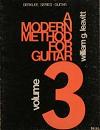
I was out tonight listening to the Mike Walsh group at the Barley Pub. As always, I learned a lot. It made me want to come home and listen to my own music, to hear it in a different perspective. I listened to a lot of the TL Duo cuts that I've posted on this site, and I found them very satisfying. But what came as a real surprise, on revisiting after many years, was the mp3 of "It's Late Again." I recorded it, many years ago, at home, long before I had the recording equipment I have today. The guitar part is actually the top guitar part from Bill Leavitt's duet "It's Late," the last duet in Volume 3 of Modern Method for Guitar. I always thought it was a pretty hip piece of music harmonically, but many of my students at the time turned up their nose at anything by Leavitt, insisting that it sounded "old fashioned." One night I dug out my Mosrite bass, laid down a sort of rock ballad bass line for the changes, then, using my Guild T-50 hollow body guitar, overdubbed the top guitar part. The next day I took the tape into Larry Baione's office and played it for him. "Tell me what this is," I said. Larry listened for a while and then said, "Is that you and me?" He didn't recognize it at all. I wrote a duet based on "It's Late," with a completely new melody, and a pick-and-fingers second guitar part. It's called "That Late?" and when I release my Guitar Duets, that will be in there. 07/21/2006 Dindi 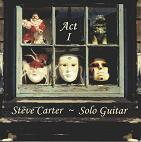
I sat on the couch tonight and, as I so often do, picked up the guitar. What came out was "Dindi," and, as I played it, I remembered something that happened maybe thirty years ago. I was sitting in my office at Berklee late one evening, with my office door open. The halls were mostly empty. Suddenly someone - a guy I didn't know -- appeared in my doorway and said, "Do you have a lead sheet for 'Dindi'?" I was somewhat taken aback, but, ever wanting to be the helpful teacher, I said, "No, but if you can come back in a while, I can have a lead sheet ready for you." I had played the tune many times with a couple of guys I used to jam with: Gordon Grant(a student of mine of mine who later joined the Berklee faculty and is now a banker in Hawaii), and Dave Chamberland (a bass student who later joined the Berklee faculty, and, later yet, replaced me as bassist for the Eastwood Swing Orchestra). The tune was a favorite of mine. I took out a piece of manuscript paper and wrote a lead sheet. The guy showed up a while later. I handed him the lead sheet. He said thanks. I never saw him again. "Dindi" continues to be one of my favorites. I recorded it twice: once with Skye on a Travelin' Light Duo CD, and once on my solo Act One CD. 07/01/2006 Chord Lab Revisited I was browsing through my old music files and I found a Chord Lab 2 mid-term exam from 1983, an exercise I wrote when I was teaching Chord Lab at Berklee. I posted it on the lessons page, or you can click here to see it. 06/24/2006 Baba Ghanoush Gets the Blues The first chord I ever learned to play on the guitar was an E chord. When I played in blues bands and played in blues jams, invariably it would be blues in E. When I got into jazz, and started playing blues with horn players, E was the last key they wanted to play in, so I played blues in Bb and blues in F. When I started working on solo guitar, I wanted to avoid the obvious crutch of using the E string for the bass note. So, for example, the first piece in my Baba Ghanosh series is a blues in G. Once I'd done that, though, I began to allow myself the luxury of using that open E string, so "Baba Ghanoush Goes South" and "Baba Ghanoush Does Motown" are (more or less) blues in E. Tonight, after a week-long hiatus from the guitar, I sat down on the couch and played a few of my favorites: "Dont' Get Around Much", "Nearness of You", Bill Leavitt's arrangement of "Prelude to a Kiss", and a few others. I had spent a good part of the day listening to family problems -- my wife was having problems with a difficult business partner, my daughter and her husband were having problems with their business -- so I felt like playing a blues. A lot of people misunderstand the blues; they think that blues tunes are just a way of feeling sad. But a blues tune can be a way of saying: sure, I feel sad, but, see, there's music and, well, it changes things, somehow. So, anyway, I played a blues in E, and it felt so good, I decided it was a keeper. So now I have a new tune, "Baba Ghanoush Gets the Blues". 06/23/2006 Get Back June was vacation month. Time now to get back to work. It's been a couple of years since I've had a full week's vacation from my day job. So this vacation has been very enjoyable. Mal and I flew out to California for our daughter Wendy's graduation from grad school. Took her to Mt. Shasta for a few days, for a real break. I only played guitar for a few minutes, picking up T's guitar to play some Baba Ghanosh pieces. Since I got back, I've only gotten as far as taking the guitar down from the hook to tune it. I'll work back in gradually, starting with ten-minute sessions of scales, arpeggios, chords, working up. While I was away, Gerry Adams called and offered me a gig subbing for him at Three Chimneys. That is always and enjoyable gig for me. The bass player is Tim Webb. Tim has a deep desire to play serious jazz, and playing background music at Three Chimneys is tough for him. But he plays great, and I think he enjoys it when I sub for Gerry. Lots to write about, to catch up. The Dover Soul gig situation, the gig at the Barley Pub, the gig at Unwined, THoTH developments.... Get back to it. 05/20/2006 Wire Review 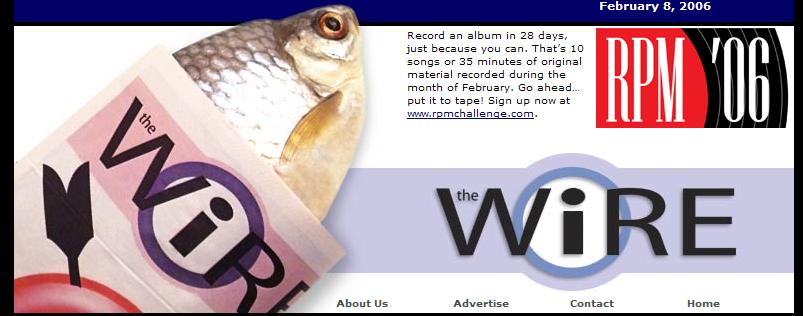
Alan Chase wrote a nice review of Act One in The Wire. Click here to read the review. Alan has been very active in the Northeast Jazz Scene group. He dropped by Dover Soul the other night to catch one of my sets. Always good to meet a local musician. He didn't have much time to chat, had to get to his job at the UNH library. But he enjoyed the music, and I appreciated his coming by.04/23/2006 THoTH 2.0 released I just released THoTH version 2.0. (See THoTH Overview) THoTH is a Windows program that provides a database of tunes and lessons. One of the things that makes THoTH unique is that it can produce a chord/scale analysis of a chord progression from a MusicXML file. 04/23/2006 Pat Metheny on chord/scale theory 
As I was putting the finishing touches on THoTH, I was reminded of some good points Pat Metheny made about chord/scale theory in a recent article: excerpted from "Pat Metheny: An Authentic Voice", Fingerstyle Guitar, No. 58 Give your thoughts on chord scale theory. Do you think this is something that is not emphasized enough or is it over emphasized? I have a funny relationship to that system and to that world because on one hand I didn't learn that way....Yet when I joined Gary Burton's band there was absolutely no way to play the kinds of tunes he was doing at the time and address them successfully in any other way and Gary happens to probably be the chord/scale expert of the universe. I've never seen anybody who can break it down as clearly and as fluently as he can. I was very much under his influence for a three-year period and sort of switched dramatically over to that way of thinking. But I have to admit that when I hear people play, let's use the word clams, like you're playing along ant it's a minor7b5 chord and I hear them play the natural 5th it really bugs me, yet at the same time it doesn't bug me because they didn't play the Locrian mode, it bugs me because it doesn't sound good....The way you get to the right answer doesn't really matter as long as it's the right answer. It certainly won't make you enjoy the performance more if the player explored what he thought. Exactly! The one beef I have with the chord scale movement is that it sort of suggests all seven notes are equally cool, when in fact that's really not the case. There really are usually four notes you want to land on that are the really, really, good ones. Then there are the others you want to get through and some you barely want to touch them. That degree of weight thing is usually not discussed because it is usually presented in the form of modal thinking rather than voice leading .My advice to people is yes, learn the chord scales but also make sure you can solo using just the chord tones. A big chunk of early jazz history was largely improvising using chord tones and improvising around the melody. Those are two valuable entry points. 03/08/2006 Portsmouth Magazine 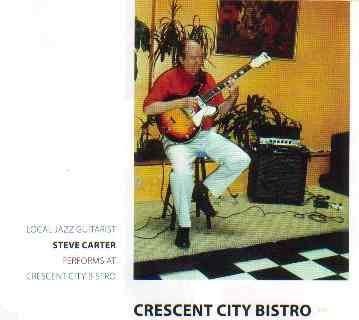
Portsmouth Magazine's graphics editor contacted me a few weeks ago and said they were doing an article on NH seacoasts restaurants. She had found a photo of me playing at Crescent City Bistro and asked if she could include it in the article. I said, sure, of course. The March issue just came out. Here's the page about Crescent City Bistro, with my picture on it. The article does a pretty good job of capturing the flavor of the Bistro, one of my favorite gigs. 02/19/2006 Ralph's House of Tone 
The output jack on my Aria guitar had a habit of working loose. Then the wires would twist around and ground out. I'd fix it by holding the jack in place by inserting a pencil eraser into the jack to keep it from rotating, and tighten the nut with a pair of needlenose pliers. Of course, after a while, it would loosen up again. I decided it was time for professional treatment. But this guitar is my baby. I've been playing it for nearly forty years. Who could I entrust it to? I'd been into Ralph's House of Tone a few times. Ralph is always friendy and helpfull. One time I went in there looking for the D'Addario round wound jazz light strings I use. Ralph didn't have them, and he said, "I don't want to try to sell you a different set of strings. If those are the ones you use, you should stick with them." That's the kind of businessman I respect. So I went into Ralph's one day to ask about the jack repair. I told Ralph it probably needed a star washer, but I'd also been getting some noise from the volume pot, though maybe that was related to loose wires. Ralph said that if it was simple, he'd do it himself, and if not, he'd give it to his luthier. Well, I didn't know his luthier, so I said I'd think about it. Russell, of Sixth Root fame, also works at Ralph's, so when I got a chance, I asked Russell's advice. He spoke very highly of the luthier and also said that Ralph does excellent work. I know that Russell is a fanatic guitar tech on his own guitars, and he always sounds great, so I took his recommendation and left my beloved Aria at Ralph's for repairs. As it turned out, Ralph did the work himself. He explained to me that he had to replace the jack, and how he draped dental floss through the f-hole to do it. He also sprayed the volume and tone controls for the neck pickup (I'd told hime it was the only pickup I use). Because the wood on the guitar body is so thick, he couldn't get a lock washer on the jack, but he put some magic stuff on there that will hold the nut in place. I plugged in to one of the amps in the store and tried the guitar out. No noice from the pot, and the tone sounded like the Aria (I'll discuss below what that means). I took the guitar home and I've been playing it at home for about a week, and the jack is very solid. Ralph does good work. It's a pleasure to find someone who takes such pride in his work -- even the minor repairs, and has such an understanding of the attachment of a player to an instrument, no matter how cheap the brand. The Aria has really cheap single-coil pickups, and I suspect that they are pretty high impedence. Plugged directly into an amp, it has very low output and a sort of muffled, somewhat nasal tone. Not a bad tone, just not very rich. And I really do have to turn any amp up to about 8 before I get any sound at all. So when I checked the Aria out at the House of Tone, I played a few chords and licks, listening to see if the odd tone I'd been getting recently -- due, I'd thought, to wires that were touching, but not bad enough to short out -- had improved. I really couldn't tell. The sound just was not good. Russell came over and adjusted the amp, so it was as good as it was going to get at the time. I told Ralph that the jack seemed solid and the noise was gone from the pot, but I couldn't tell about the tone, and I started explaining about the pickups. Ralph said, "The tone is all in the hands, anyway, and you sound great." He meant it. Nice to hear. Not since the days of Bob Cavenaugh at Wurlitzer's in Boston, have I met a guitar repairman who really understood. So Ralph's work was excellent, but, as I played the guitar at home through my Peavey amp, I was still getting a little of that nasal tone (I've written about it in a previous entry.) Then it struck me: maybe it's the preamp! For about 20 years I've been using an MXR preamp, a little white stomp box, to boost the volume of the Aria, and to improve the tone. All guitar pickups, but especially single-coil pickups, suffer some loss of highs and lows because of impedence mismatch with amplifier inputs. My Aria is particularly prone to this. The preamp eliminates the problem. But I realized that I hadn't changed the battery in the preamp in a very long time. I opened the premap up and when I took out the battery I saw that I'd written the date on it: July 7 2003. I used to change the battery about once a year. So probably the battery was very low; not low enough to stop working altogether, but low enough to cause erratic performance. I put in a fresh battery and the electric sound of the guitar came back to life. Tuesday night I have my first gig since the guitar repair. The gig is at my favorite local venue, Dover Soul. I'm really excited about the gig, because I feel like I'll be going in there with a new guitar -- or better yet, an old much-loved one, recently brought back to good health. 02/09/2006 Sonic Impact 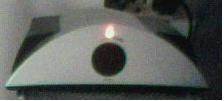
I wanted a stereo for the middle floor in our condo. On the bottom floor I have an Onkyo sytem with big Advent Legacy speakers, and in my office on the top floor I have an Onkyo system with Advent bookshelf speakers, but I had no stereo on the middle floor. I had a pair of small Advent indoor-outdoor speakers I wanted to use, so I wanted a small CD player and amp. I bought a $39 DVD player. I had read about the Sonic Impact T-amp, and ordered one. It's small enough to sit in the palm of my hand, weighs only as much as a handfull of CDs, and costs $29.95, but it produces more than enough sound to fill the room -- and it's a big room: three rooms, actually, living room, kitchen, dining room, in an open floor plan, about 500 square feet. Quite amazing to hear so much sound coming from that little box. As soon as the first sounds issued from the new system, Mal said, "It sounds better than downstairs!" My initial reaction was "No!" Can't be. How can this little 6-watt amp and these small speakers sound better than the 50-watt Onkyo receiver and those waist-high Advent speakers? But she was right. Part of the difference in the sound is the openness of the middle floor, with all the contours bouncing the sound in interesting ways. But most of it is this incredible amp. For classical music, clarity presence in the high strings and woodwinds, warmth in the basoons and cellos. For jazz, crispness in the snare drum, sizzle in the cymbols, character in the horns and guitars. The sound stage is wide and well-defined. The only thing lacking in the new system was the extreme lows. The T-amp rolls off steeply at 100Hz. That, combined with the physical limitations of the small speakers, leads to a lack of bottom. The frequency of the low E string on guitar is about 82Hz, so even a relatively high-pitched instrument like guitar looses something due to that roll-off. And string bass, with it's lowest frequency around 41Hz is nearly eliminated from the mix. So I started searching for alsubwoofer. After a lot off web surfing, looking at subwoofers that cost thousands of dollars and attempt to be a prominent piece of furniture, I found myself back on the Sonic Impact site. I ordered their $89 MiniMaxx. A 7.5" cube, it's small enough to hide behind a CD rack, but it provides all the lows I was missing. The first test was Berlioz' Fantastic Smphony. Even with the subwoofer set low, the basses and timpany had all the fullness and depth I could want. I put on various bass players -- Ron Carter, Brian Torff, John Neves -- and was pleased that they sounded very much as they would sound live. So for under $200, I have high-end stereo in my livinglroom, and I'm loving it! As I write this, I'm listening to Bob Winter and Carol Ackerman, "Quit Nights." Here in the room with me. 02/08/2006 Dover's got soul 
I was recently interviewed for an article in The Wire about the music series at Dover Soul. Click here to read the article. 01/28/2006 Stirred I went out Thursday night to hear my old friend Gerry Adams, and my new friend, Tim Webb, at the ffrost Sawyer Tavern (yes, that is how it is spelled!) in the Three Chimneys Inn in Durham. I talked with them for a while before and after their last set. Tim has started a new website, www.nejazzscene.com, to promote jazz in the Northeast. It's a great site, and an even better concept. He's bringing together jazz musicians in the area, and stirring up an interest in stirring up an interest in jazz. I had the pleasure of playing once with Tim, and he had sounded quite good, but Thursday night he was stirred up, and he sounded great. Gerry sounded great also. Last time I'd heard him he was playing his 335, but Thursday night he was playing his Howard Roberts Gibson. I was sitting close enough to hear the acoustic sound of the guitar when he did some samba comping behind Tim's bass solo. Very nice. 01/01/2006 Stand in the living room 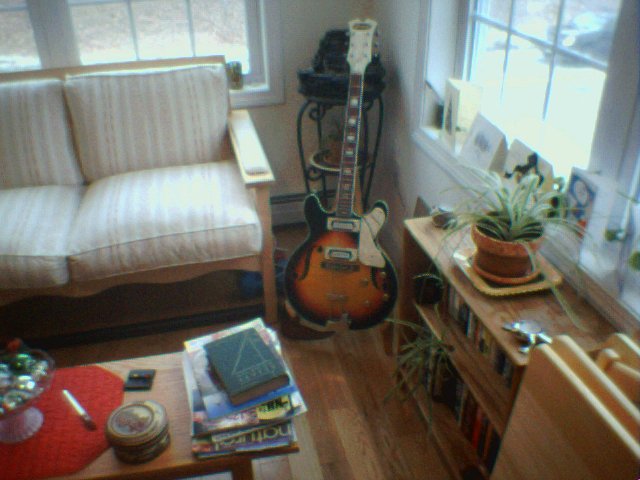
I usually practice in my office, where I keep two guitars haning on wall hooks. As I mentioned in an earlier post, I often play guitar in the living room, and I did not have a guitar stand there. I play while my wife is cooking, and when dinner is ready, I was in the habit of laying the guitar on the couch. I'm a notorious equipment-worrier, and, although the guitar was probably perfectly safe, I imagined all kinds of unlikely events that would cause it to crash to the floor. So I ordered a Silver Creek wooden guitar stand (photo) and I'm quite happy with it. I wanted a wooden stand that would blend with the light wood in the room. The stand is attractive and folds for storage. It does not have pegs that surround the neck, as most guitar stands do, so I was concerned that it might be easy to tip over, but I've found it's surprisingly stable. The body of the guitar sits in two curved holders that swivel to adjust to the size of the guitar. The holders have cork padding, which grips the guitar and prevents sliding. Both my thin-body Aria and my hollow-body Guild sit securely in the stand. The back of the guitar leans against the stand; there are felt pads at the points of contact. To be sure the stand was stable, I attempted to tip the guitar to the sides, front, and diagonally back (being prepared to catch it, of course). Even a determined push was not enough to topple the stand, or to move the guitar in the stand. I'm quite impressed with the design, and I feel confident leaving the guitar in the stand, in spite of the fact that it looks precarious. |
